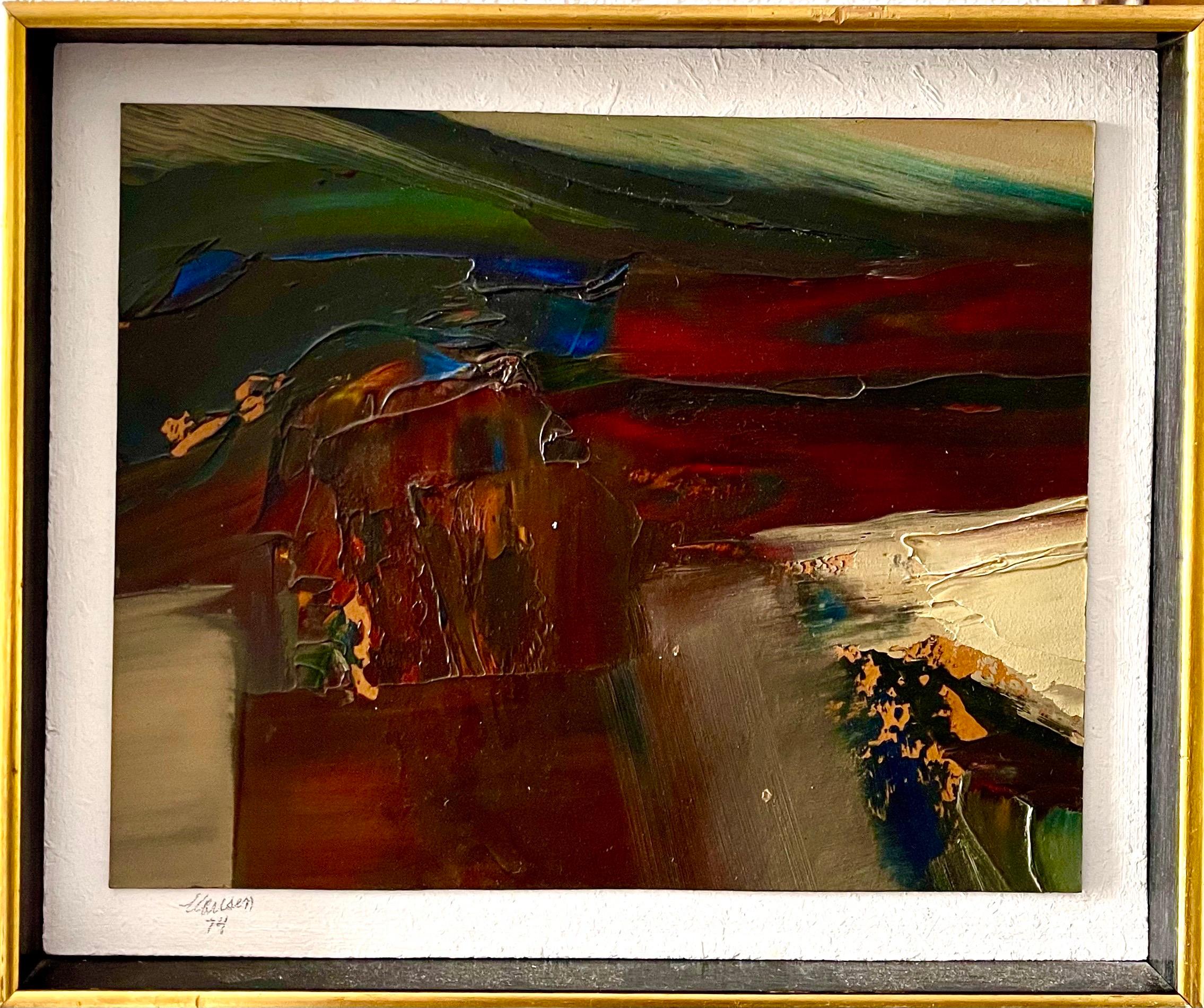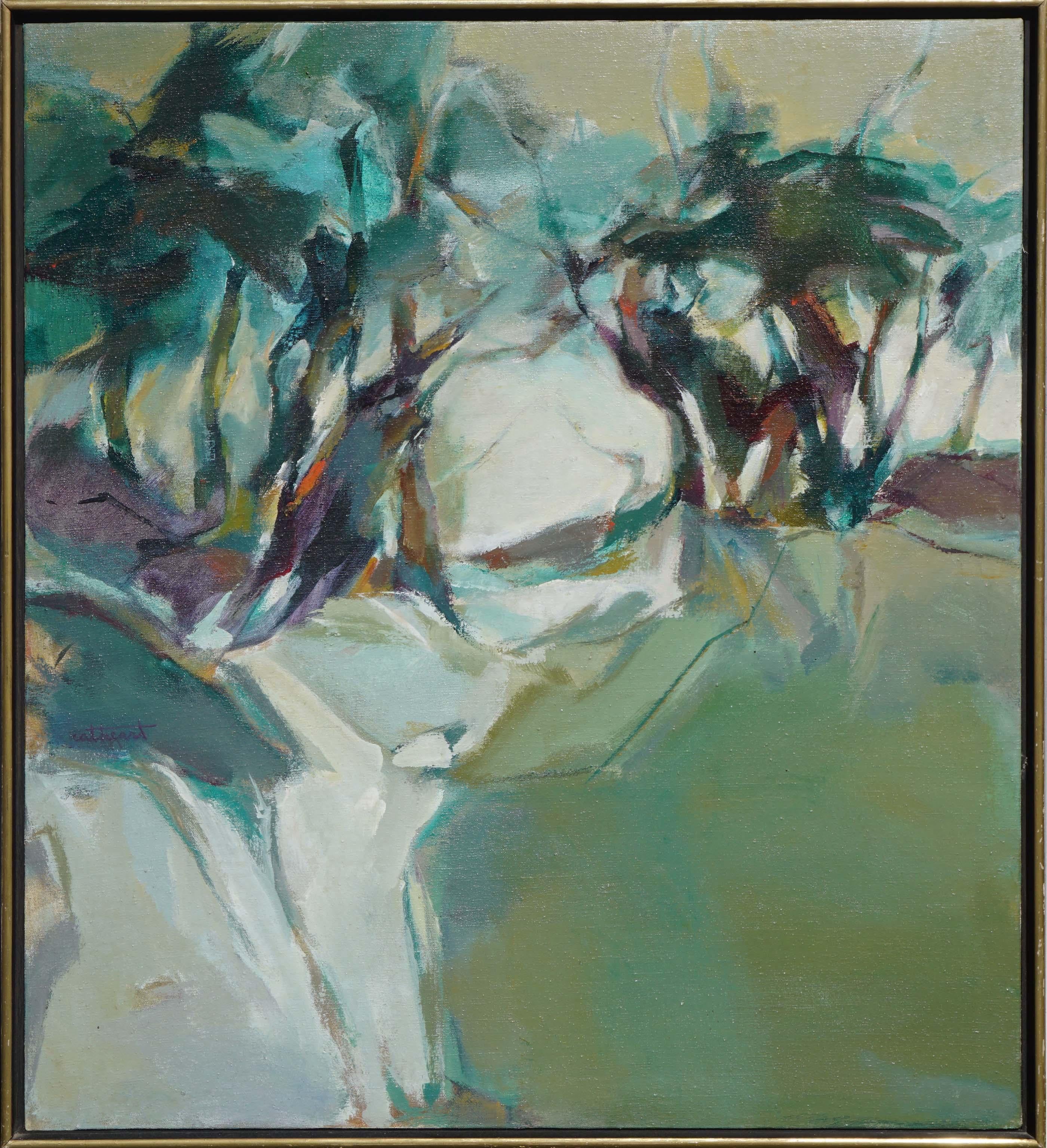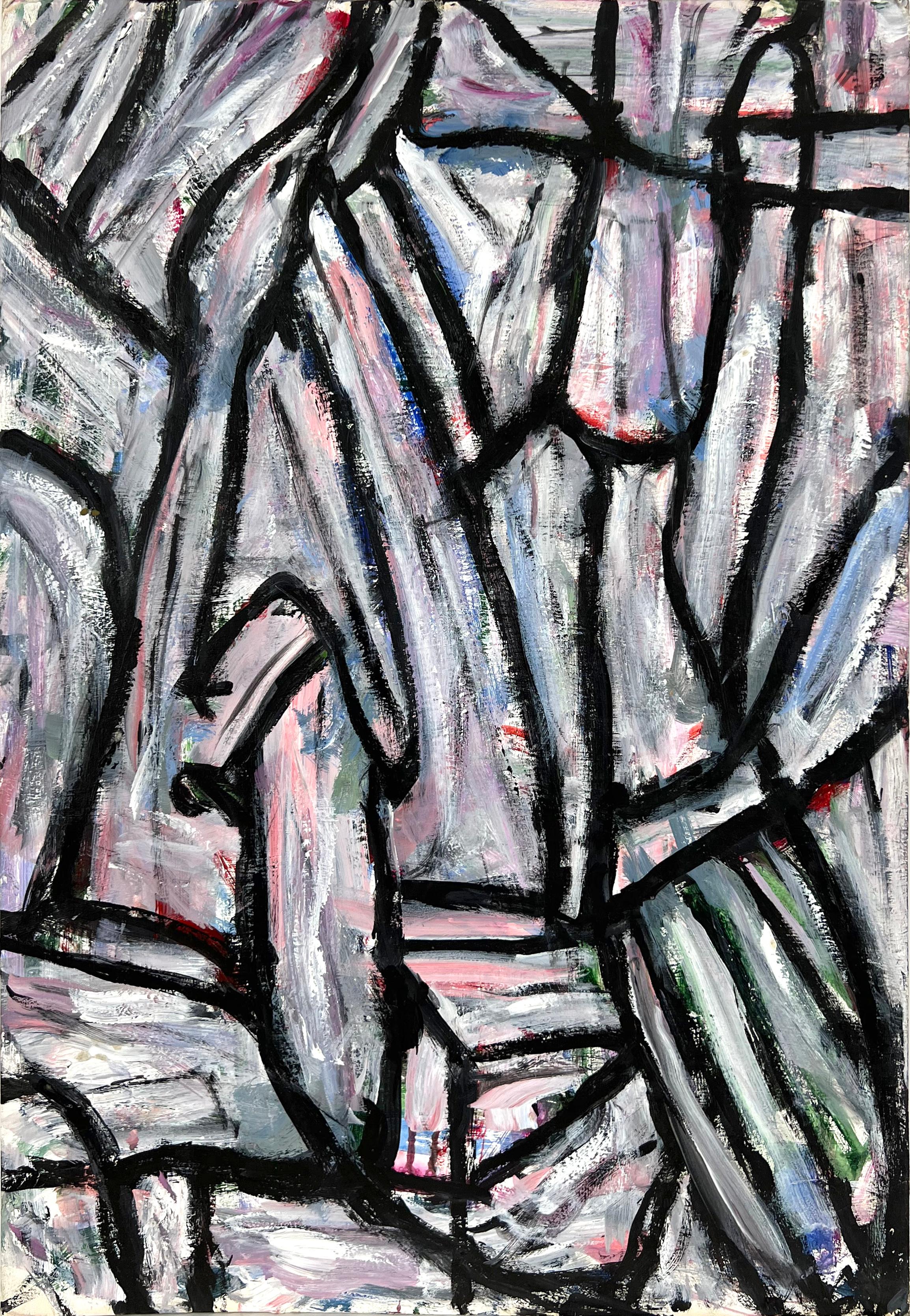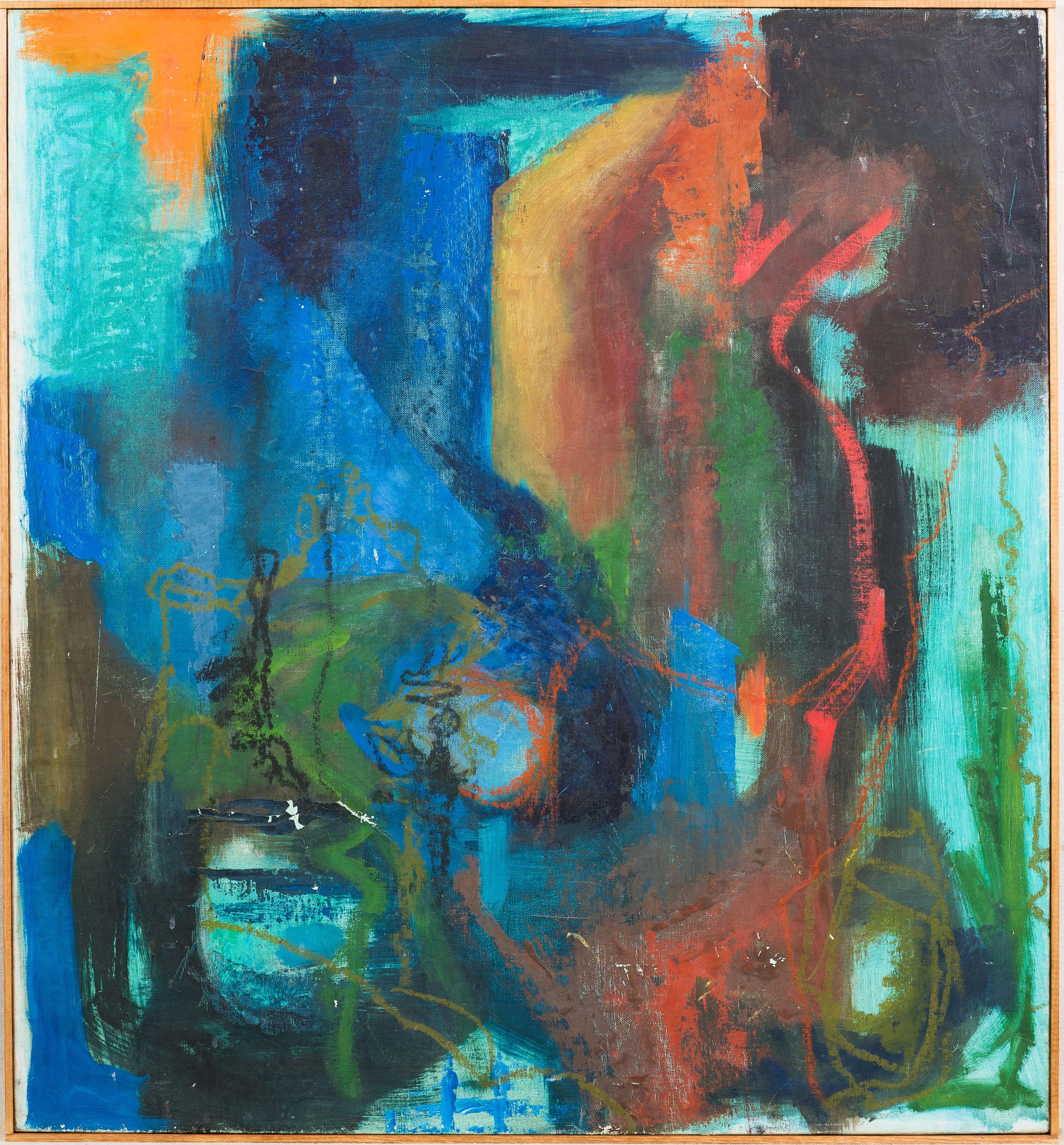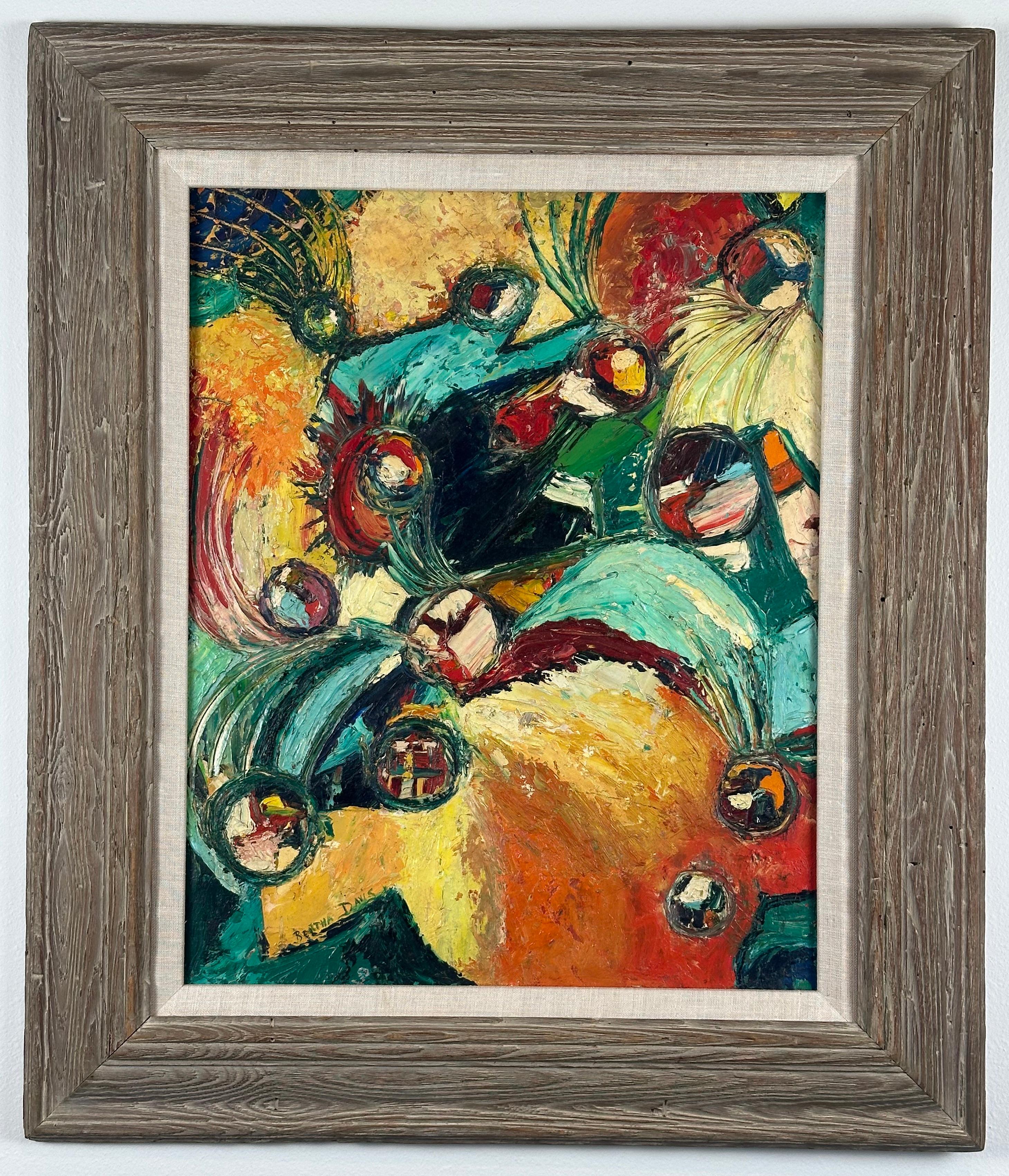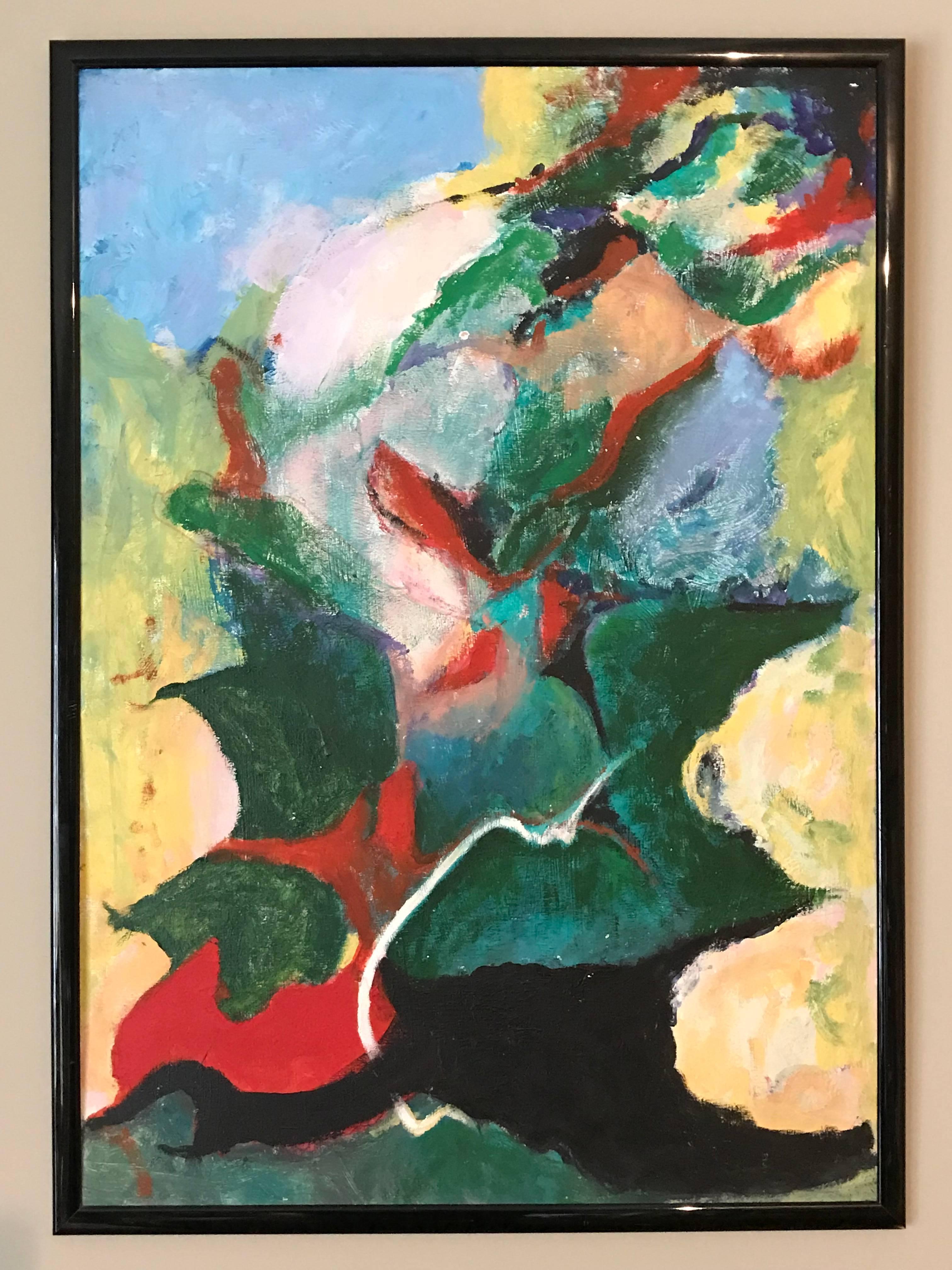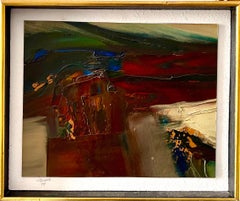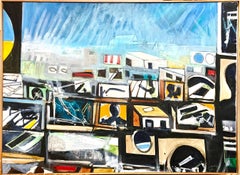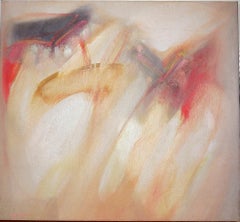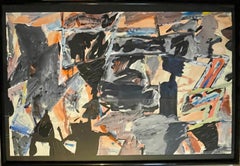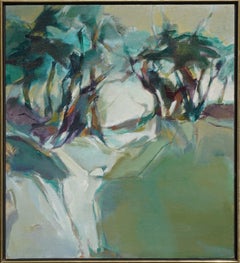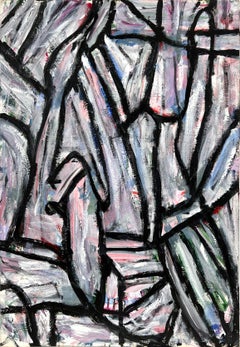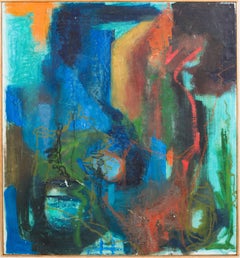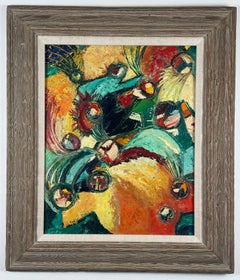Items Similar to Nell Sinton Abstract Expressionist Landscape San Francisco California Modernist
Want more images or videos?
Request additional images or videos from the seller
1 of 18
Eleanor Nell SintonNell Sinton Abstract Expressionist Landscape San Francisco California Modernistc.1950
c.1950
$4,500
£3,339.17
€3,889.68
CA$6,264.03
A$6,975.57
CHF 3,630.40
MX$86,007.88
NOK 46,235.87
SEK 43,457.24
DKK 29,021.84
Shipping
Retrieving quote...The 1stDibs Promise:
Authenticity Guarantee,
Money-Back Guarantee,
24-Hour Cancellation
About the Item
Eleanor Nell Sinton
Roots and Stems 1950,
Oil on canvas,
Signed lower right N. Sinton,
Provenance: Braunstein Quay Gallery (bears label verso)
Framed: 24.5 X 20.5 sight 21 X 17 inches.
Nell (Eleanor) Sinton (1910-1997) was a painter, art collector and educator in San Francisco, California
Nell Sinton began painting in the 1920s. She studied at the San Francisco Art Institute (then called the California School of Fine Arts). Nell Sinton, one of the early California woman abstract expressionist painters.
A member of a family that moved to San Francisco in 1851, Nell Sinton began painting in the 1920s. She studied at the San Francisco Art Institute (then called the California School of Fine Arts) a decade before abstract expressionism emerged there, and, later, with Lucien Labaudt and Maurice Sterne, (1937-1938). She also worked as an apprentice to Sterne on the Federal Art Project (WPA) murals in San Francisco (1938-40) and was a member of the San Francisco Art Commission (1959-63). In 1959, Sinton was acknowledged as one of the Ten Most Distinguished Bay Area Women. A notable Bay Area Expressionist painter, she was also a member of the Board of Trustees of the San Francisco Art Institute from 1966-1972. Nell Sinton is well-listed in all relevant art reference works including Who Was Who in American Art and Artists in California (1786-1940). Her style evolved from figurative family scenes and cityscapes to abstract oils and watercolors, collages, assemblage and sculpture constructions. Sinton has often incorporated collage of some type with acrylic painting. Sinton was acknowledged as one of the Ten Most Distinguished Bay Area Women and was an active member of the Bay Area art community and also served on the San Francisco City and County Art Commission, 1959-1963 and the Board of Trustees of the San Francisco Art Institute from 1966-1972.
She was in a show at Foster-Gwin art & antiques of works by woman artists who helped build the Abstract Expressionist movement in San Francisco Bay area. Artists included Jay DeFeo, Emiko Nakano and Nell Sinton.
The Smithsonian collection houses "Nell Sinton, An Adventurous Spirit: The Life of A California Artist," (oral history, University of California, Berkeley, 1993); Motion picture films include footage by Coni Beeson of Sinton at work with Delia Moon, and "Scroll: The Social Development of an American Female" (1976). A small portion of the material including letters from Jay DeFeo and Wally Hedrick (DeFeo's former husband) to Eleanor (Nell) and Stanley Sinton.
She has multiple works in the collection of SFMOMA. Sinton's work has been exhibited in solo and group shows at museums including the San Francisco Museum of Art and the California Palace of the Legion of Honor, Chicago Art Institute, Los Angeles County Museum, Metropolitan Museum of Art in New York and the Oakland Art Museum. In 1981, Mills College held a 30-year retrospective exhibition of Sinton's work dividing her still-active career into several periods. The earliest works, from the 1940s, were naïve and charming interiors and landscapes. From the 1960s came the Abstract Expressionist paintings, voluptuous, “loosely formal” compositions exploding in riots of color and exposing, said Art Week, Sinton-the-poet at her best. Next came her figurative phase, somewhat in the manner of David Park and Richard Diebenkorn. Then there were small mixed-media constructions and, in the late 1970s, a Garden Party series thick with social satire. She showed at the Braunstein-Quay Gallery in San Francisco (they held her estate as well as John Altoon and Peter Voulkos). Besides painting, Sinton served for several years on the San Francisco Art Commission. She also taught workshops at University of California at Berkeley and Irvine, Mount Holyoke and Smith colleges and elsewhere. The SF Art Institute played a major role in developing San Francisco’s international reputation as a tolerant and innovative environment for art, music, and political expression. The school was particularly influential in nurturing an open-minded atmosphere and as a result many of these rebellious and creative artists mixed with the poets, writers, “The Beats”, and jazz musicians, to help bring new ideas of freedom and creativity to the San Francisco Scene. The faculty, with locals Hassel Smith, Richard Diebenkorn, and David Park, was quickly joined by artists such as Clyfford Still, Mark Rothko, and Ansel Adams. She is included in the San Francisco Art Institute library artists’ book collection which includes both unique and classic titles from the 1950s through the present. The collection is particularly strong in conceptual and humorous titles of the 1960s and 1970s by artists such as Bruce Nauman, John Baldessari, Ed Ruscha, Alan Kaprow, Michael Snow, and Chris Burden, William T. Wiley, Larry Sultan, Nell Sinton, Yoko Ono, Lorna Simpson and Kiki Smith.
SOLO EXHIBITIONS
California Palace of the Legion of Honor, 1949; Santa Barbara Museum of Art, 1950; Bolles Gallery, New York and San Francisco, 1962; Quay Gallery, San Francisco, 1966, 1969, 1971, 1974; San Francisco Museum of Art, 1970; Louisiana State University, Baton Rouge, 1976; Oakland Museum, 1990.
SELECTED GROUP EXHIBITIONS
Fifth Annual Exhibition of Contemporary Painting, California Palace of The Legion of Honor, 1952; Winter Invitational, California Palace of The Legion of Honor, San Francisco in addition to group shows at the San Francisco Museum of Art, including "Corridor: Fred Martin, Roy De Forest, Tony Delap, Nell Sinton," at San Francisco Museum of Modern Art, the Chicago Art Institute, the Los Angeles County Museum and New York’s Metropolitan Museum of Art.
PUBLIC COLLECTIONS
The Oakland Museum; San Francisco Museum of Modern Art
BIBLIOGRAPHY
Painting and Sculpture in California: The Modern Era; Thomas Albright, Art in the San Francisco Bay Area, 1945-1980; Susan Landauer, The San Francisco School of Abstract Expressionism; The Art of California, Selected Works from the Collection of The Oakland Museum; San Francisco Museum of Modern Art, The Painting and Sculpture Collection.
- Creator:Eleanor Nell Sinton (1910 - 1997, American)
- Creation Year:c.1950
- Dimensions:Height: 24.5 in (62.23 cm)Width: 20.5 in (52.07 cm)
- Medium:
- Movement & Style:
- Period:
- Condition:good. minor wear to frame.
- Gallery Location:Surfside, FL
- Reference Number:1stDibs: LU3829673072
About the Seller
4.9
Platinum Seller
Premium sellers with a 4.7+ rating and 24-hour response times
Established in 1995
1stDibs seller since 2014
1,777 sales on 1stDibs
Typical response time: 1 hour
- ShippingRetrieving quote...Shipping from: Surfside, FL
- Return Policy
Authenticity Guarantee
In the unlikely event there’s an issue with an item’s authenticity, contact us within 1 year for a full refund. DetailsMoney-Back Guarantee
If your item is not as described, is damaged in transit, or does not arrive, contact us within 7 days for a full refund. Details24-Hour Cancellation
You have a 24-hour grace period in which to reconsider your purchase, with no questions asked.Vetted Professional Sellers
Our world-class sellers must adhere to strict standards for service and quality, maintaining the integrity of our listings.Price-Match Guarantee
If you find that a seller listed the same item for a lower price elsewhere, we’ll match it.Trusted Global Delivery
Our best-in-class carrier network provides specialized shipping options worldwide, including custom delivery.More From This Seller
View All1974 California Bay Area Abstract Expressionist Bold Oil Painting Don Clausen
By Don Clausen
Located in Surfside, FL
Don Clausen American (b. 1930)
Untitled (1974)
Oil on board
Hand signed lower left and verso
Framed 11.25 X 13.5 sight 9 x 11.25 inches
Don Clausen is an American Postwar & Contem...
Category
1970s Abstract Expressionist Abstract Paintings
Materials
Oil, Board
Large John Hultberg SF Bay Area Artist Abstract Expressionist Oil Painting
By John Hultberg
Located in Surfside, FL
John Hultberg
Oil on canvas
Panorama of pictures. 1998
Hand signed lower right, J. Hultberg ‘98.
Artist, date, and title written on verso.
Canvas 25.5”H x 35”W, Frame 26”H x 35.5”W.
Oil painting depicting a mosaic of photographs overlooking an abstract geometric landscape.
John Hultberg (1922 – 2005) was an American Abstract expressionist and Abstract realist painter. Early in his career he was related to the Bay Area Figurative Movement; he was also a lecturer and playwright.
John Hultberg was born in 1922 in Berkeley, California. Hultberg attended Fresno State College, graduating in 1943. During World War II, he was a Navy lieutenant. After the war, his education at the California School of Fine Arts (CSFA) (now the San Francisco Art Institute) was funded by the G.I. Bill. His teachers included Mark Rothko and Clyfford Still and he was a classmate of Richard Diebenkorn, who was also a mentor, James Budd Dixon, Walter Kuhlman, Frank Lobdell, and George Stillman, which whom he created a portfolio of 17 lithographs. This 1948 portfolio, titled Drawings, has been acknowledged as a landmark in Abstract Expressionist printmaking. The group has been referred to as "The Sausalito Six," because most, lived in Sausalito, north of San Francisco. Many of the "First Generation" artists in this West Coast movement were avid fans of Abstract Expressionism, and worked in that manner, until several of them abandoned non-objective painting in favor of working with the figure. Among these First Generation Bay Area Figurative School artists were: David Park, Richard Diebenkorn, Rex Ashlock, Elmer Bischoff, Glenn Wessels, Wayne Thiebaud, Raimonds Staprans, and James Weeks. The "Bridge Generation" included the artists: Henrietta Berk, Nathan Oliveira, Theophilus Brown, Paul Wonner, Roland Petersen, John Hultberg, and Frank Lobdell. He was also a contemporary of Clay Spohn and David Park. Hultberg studied at the Art Students League of New York beginning in 1952. Hultberg was first married to Hilary Blech. In 1961 Hultberg met fellow artist Lynne Mapp Drexler...
Category
1990s Abstract Expressionist Abstract Paintings
Materials
Canvas, Oil
Untitled Abstract Expressionist Painting Ojai California Artist Wesley Johnson
By Wesley Johnson
Located in Surfside, FL
A listed California painter, muralist, and teacher, Wesley Johnson was born in Ojai, California in 1934, and educated at Ventura College and the University of California, Santa Barbara. He was also a pupil of Howard Warshaw and Andre L'Hote. The cubist style of Warshaw, combined with the airy and light feeling of impressionism and the abstraction of expression, influenced Johnson's style of painting. His paintings often contain large, sweeping strokes, but a subtle use of color that evocative of his spontaneous, non-objective style.
Wesley Johnson is an Abstract Expressionist with strong influences from Cubism and Impressionism. His work has run the gamut from figurative murals painted on the commissary walls at Fort Ord, to large, colorful abstract oils...
Category
20th Century Abstract Expressionist Abstract Paintings
Materials
Canvas, Oil
Large Harry Bertschmann Swiss American Abstract Expressionist Outsider Painting
By Harry Bertschmann
Located in Surfside, FL
Harry Bertschmann (Swiss American, born 1931).
Acrylic painting on paper.
Artist signature to lower right.
Provenance: Joy Moos Gallery (this was exhibited at the Outsider Art Fair)
...
Category
20th Century Abstract Expressionist Abstract Paintings
Materials
Paper, Acrylic
Lyrical Abstract Israeli Expressionist Oil Painting
By Hanna Ben Dov
Located in Surfside, FL
Hanna Ben Dov is an Israeli abstract painter who was born in Jerusalem in 1919 and died in Paris in 2008.
Ben Dov's father, Yacov Ben-Dov, was a famous Israeli photographer who founded the photography department in the Bezalel Academy of Art and Design in 1910. Hannah herself attended Bezalel during the 1940s, and later continued to Camberwell College of Arts in London. After the completion of her formal education she moved to Paris, where she exhibited for the first time in 1948 and has been living and working there since, as a part of the local abstract artists school. She took part in the first French Biennale of 1951, that was held in Menton.
Collections
Her paintings can be found in several collections, including the French State Collection, the Tel Aviv Museum of Art collection, the Bezalel National Museum collection in Jerusalem and the Rockefeller Museum collection in New York.
Ben Dov resided for her last two years at the Maison Des Artistes Home in Nogent-Sur-Marne, France, just outside Paris.
Exhibitions
Gallery97 Tel Aviv Paintings...
Category
20th Century Modern Landscape Paintings
Materials
Canvas, Oil
American Vivid Abstract Expressionist Art Oil Painting Norman Carton, WPA Artist
By Norman Carton
Located in Surfside, FL
Norman Carton (1908 – 1980) was an American artist and educator known for abstract expressionist art. He was born in the Ukraine region of Imperial Russia and moved to the United States in 1922 where he spent most of his adult life.
A classically trained portrait and landscape artist, Carton also worked as a drafter, newspaper illustrator, muralist, theater set designer, photographer, and fabric designer and spent most of his mature life as an art educator. Carton showed in and continues to be shown in many solo and group exhibitions. His work is included in numerous museums and private collections throughout the world.
Norman Carton was born in the Dnieper Ukraine territory of the Russian Empire in 1908. Escaping the turbulence of civil war massacres, he settled in Philadelphia in 1922 after years of constant flight. While attending the Pennsylvania Museum School of Industrial Art, Carton worked as a newspaper artist for the Philadelphia Record from 1928 to 1930 in the company of other illustrator/artists who had founded the Ashcan School, the beginnings of modern American art. From 1930 to 1935, he studied at the Pennsylvania Academy of Fine Arts under Henry McCarter, who was a pupil of Toulouse-Lautrec, Puvis de Chavanne, and Thomas Eakins. Arthur Carles, especially with his sense of color, and the architect John Harbison also provided tutelage and inspiration. Following his time at the Pennsylvania Academy of Fine Arts, Carton studied at the Barnes Foundation from 1935 to 1936 where he was influenced by an intellectual climate led by visiting lecturers John Dewey and Bertrand Russell as well as daily access to Albert C. Barnes and his art collection.
Carton was awarded the Cresson Traveling Scholarship in 1934 which allowed him to travel through Europe and study in Paris. There he expanded his artistic horizons with influences stemming from Henri Matisse, Pablo Picasso, Chaim Soutine, and Wassily Kandinsky. While at the Pennsylvania Academy of Fine Arts, Carton was also awarded the Toppan Prize for figure painting as well as the Thouron Composition Prize. He received numerous commissions as a portrait artist, social realist, sculptor, and theatrical stage designer as well as academic scholarships. During this time, Carton worked as a scenery designer at Sparks Scenic Studios, a drafter at the Philadelphia Enameling Works, and a fine art lithographer.
From 1939 to 1942, the Works Progress Administration (WPA) Federal Art Project employed Carton as a muralist and easel artist. He collaborated with architect George Howe. The WPA commissioned Carton to paint major murals at the Helen Fleischer Vocational School for Girls in Philadelphia, the Officers’ Club at Camp Meade Army Base in Maryland, and in the city of Hidalgo, Mexico. Throughout the 1940s, Carton exhibited and won prizes for his semi-abstract Expressionist and Surrealist paintings. He socialized with and was inspired by Émile Gauguin and Fernand Leger. During World War II, Carton was a naval structural designer and draftsman at the Cramps...
Category
Mid-20th Century Abstract Expressionist Landscape Paintings
Materials
Canvas, Oil
You May Also Like
Abstract Treescape Landscape Berkeley School Abstract Expressionist
By Marjorie Cathcart
Located in Soquel, CA
Abstract Treescape Landscape Berkeley School Abstract Expressionist
Substantial period Berkeley School abstract expressionist landscape titled "Treescape" by listed Berkeley artist...
Category
1970s Post-Modern Landscape Paintings
Materials
Canvas, Acrylic, Stretcher Bars
Bay Area Abstract Expressionist Oil on Illustration Board Honora Berg Berkeley
By Honora Berg
Located in Soquel, CA
San Francisco Bay area abstract expressionist painting by Honora Berg (American, 1897-1985). A nocturnal setting adds more interest and dimension.
Estate stamp on verso "Estate of Honora Berg-Larry Miller Fine Art"
Unframed. 36"H x 30"W.
Larry Miller 1958-2003, Larry was a specialist in bay area abstract artists and purchased numerous bay area artists estates. He purchased the entirety of the Honora Berg Estate and we purchased many of those works directly form Larry.
Honora Berg, an Abstract Expressionist and Bay Area Figurative School artist, studied at the San Francisco Art Institute with David Park, Elmer Bischoff and James Budd Dixon...
Category
1950s Abstract Expressionist Abstract Paintings
Materials
Oil, Illustration Board
$1,480 Sale Price
20% Off
Vintage American Modernist Abstract Expressionist Framed Landscape Oil Painting
Located in Buffalo, NY
Antique American modernist abstract landscape oil painting. Oil on canvas. Framed. No signature found.
Category
1950s Abstract Abstract Paintings
Materials
Canvas, Oil
$1,196 Sale Price
20% Off
Untitled (Abstract Expressionist Painting)
By Bertha Davis
Located in Wilton Manors, FL
Bertha G. Davis (1911-1997)
Untitled, ca. 1960's
Oil on cradled masonite panel.
16 x 20 inches; 24 x 28 inches framed.
Signed lower left. Artist estate stamp on verso.
Vintage custom wormy chestnut frame.
A painter of cityscapes, landscapes, and abstracts in Texas, Bertha G Davis was primarily a self-taught artist whose style was influenced by her early life experiences in pre-World War II Lithuania and later Mexico. Her style is expressionistic*, relying on color to denote her profound feelings. She works primarily in watercolor and acrylic with some mixed media*.
She is the daughter of Abraham and Dvora Germaize of Vilna, Lithuania and grew up in Jewish ghettos in Vilna, Alita, and Kovno. Davis was influenced by her father who was a decorative wood-worker and carpenter in Lithuania. The family of five daughters and a son escaped to Mexico City in the late 1920’s because of Jewish oppression. The images and emotions she experienced had no outlet.
She was known as a beauty, and at age 17 was named Jewish Miss Mexico, barely able to speak Spanish having just emigrated from Eastern Europe. Irving Davis, a merchant from Texas who had also come from Eastern Europe via Cuba, saw her at this event where she was crowned Jewish Miss Mexico, and three days later asked for her hand in marriage. They moved to a small town in Texas, raising a family.
Her daughter, Sylvia, was born when Davis was 20 and they were inseparable. As Sylvia became an actress, painter, and sculptor, Davis was amazed at the capacity for creativity. Davis didn’t begin her own artistic journey until she was 47, when her daughter Sylvia Caplan encouraged her to try. She was inspired by this daughter who gave her a drugstore palette of watercolors, paper and brushes and told her to “just try.” Davis did not put down her palette and brushes until her death in 1997.
Bertha G Davis was primarily self-taught but maintained a style oriented toward color and texture that reflected her strong feelings. Most of her early work was done while she lived in McAllen, Texas where she was known for her contribution to art and showed her work and the work of other artists at the Bertha Davis Gallery.
She studied with Stewart Van Orden, at Pan American College in 1960-61; and was a student at the Art Institute San Miguel Allende, Mexico, 1965. She was also a student of Harold Phenix...
Category
Mid-20th Century Abstract Expressionist Abstract Paintings
Materials
Masonite, Oil
$975 Sale Price
35% Off
Large French Expressionist Abstract Oil Painting
By Armand Rottenberg
Located in Cirencester, Gloucestershire
Expressionist Composition
by Armand Rottenberg (French 1903-2000)
oil painting on board, framed
Provenance: the artists estate
Framed 37 x 28 inches
Stunning original Cubist painti...
Category
Late 20th Century Abstract Expressionist Abstract Paintings
Materials
Oil
$2,551 Sale Price
30% Off
Berkeley Hills Abstract Landscape
Located in Soquel, CA
Vivid multicolored abstract expressionist painting of the Berkeley hills in the style of John Marin by J.P Tipton Sr. (American, 20th Century), 2003. Pr...
Category
Early 2000s Abstract Expressionist Abstract Paintings
Materials
Oil, Board
$1,480 Sale Price
20% Off
